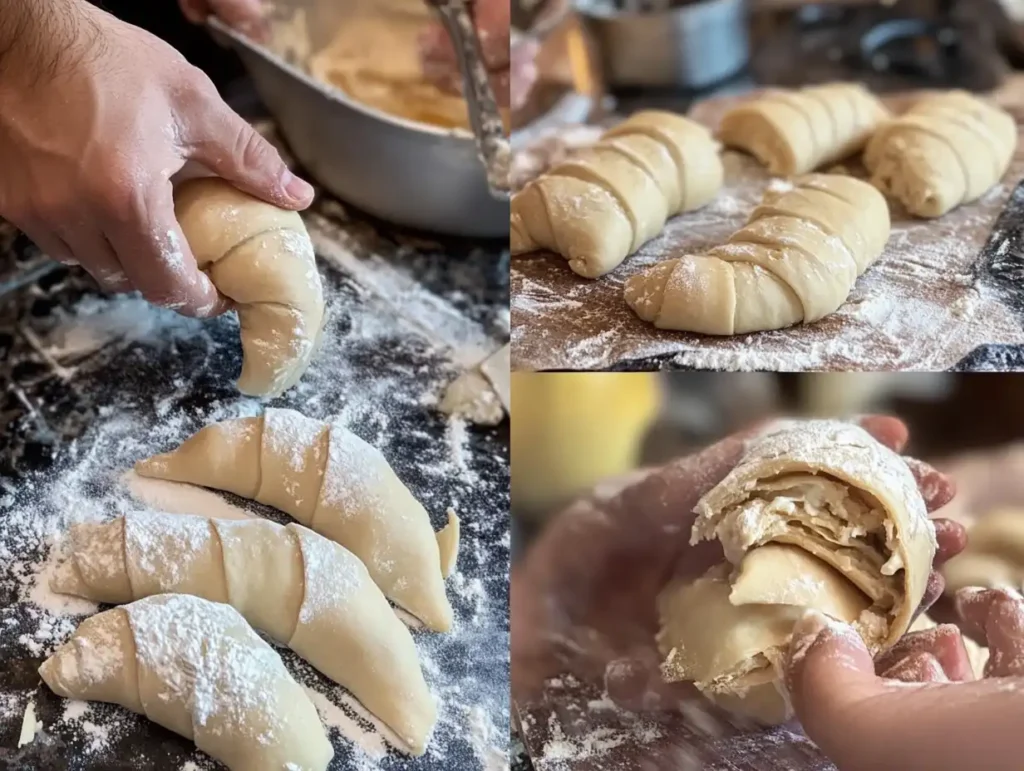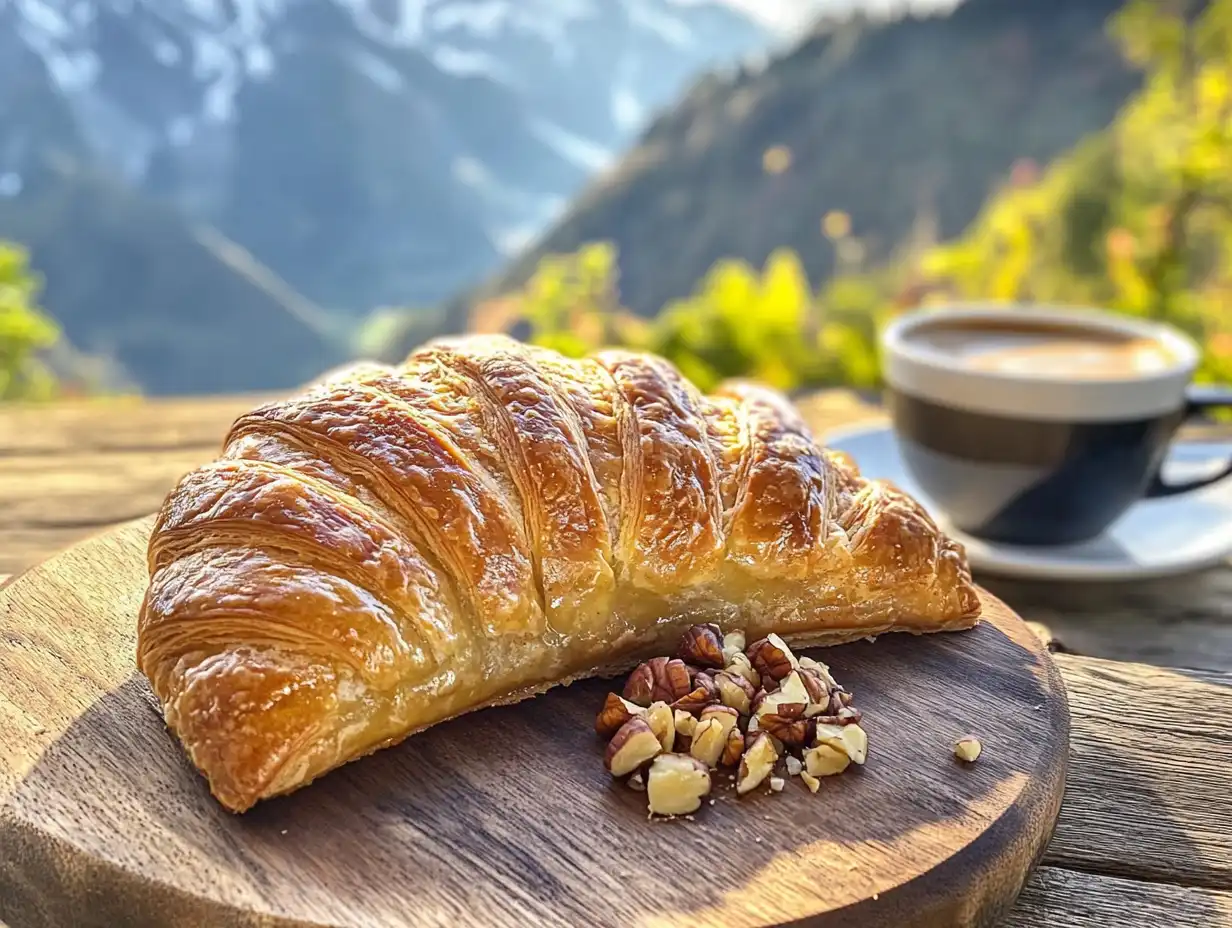Introduction
What is a Nussgipfel? Simply put, it is a delightful Swiss pastry filled with a rich nutty core and encased in flaky, buttery dough. The name “Nussgipfel” translates to “nut crescent,” perfectly describing its crescent shape and nut-based filling. This iconic treat is cherished in Switzerland as a breakfast or afternoon snack. In this article, we’ll dive into the history, ingredients, and preparation of the Nussgipfel, answering the question: what is a Nussgipfel, and why is it so beloved?
Origins of the Nussgipfel
History of the Nussgipfel
To truly understand what a Nussgipfel is, we need to explore its origins. This pastry has deep roots in Swiss baking traditions. Its development was influenced by the availability of nuts like walnuts and hazelnuts in Alpine regions, where resourceful bakers combined them with flaky dough to create a treat that has stood the test of time.
Cultural Significance in Switzerland
What is a Nussgipfel’s role in Swiss culture? Beyond being a pastry, it symbolizes hospitality and celebration. It is a staple in Swiss households, often featured during gatherings and festive occasions. Its versatility as a travel-friendly snack has made it popular among both locals and tourists.
What Makes a Nussgipfel Special?
Unique Ingredients
A defining feature of what makes a Nussgipfel so special is its quality ingredients. The pastry dough is similar to croissant dough, while the nut filling is made from finely ground walnuts, sugar, and cinnamon, creating a rich, satisfying bite.
Traditional Preparation Methods
When considering what a Nussgipfel truly is, the preparation process is crucial. Traditional methods include folding butter into dough for optimal flakiness and carefully crafting the crescent shape to ensure the filling is perfectly enclosed.
Ingredients of a Nussgipfel
Dough Ingredients
The foundation of a Nussgipfel lies in its buttery, flaky dough. Typically made from flour, unsalted butter, milk, yeast, sugar, and a pinch of salt, the dough is similar to puff pastry or croissant dough. Its light, airy texture comes from the lamination process, where layers of butter are folded into the dough multiple times.
Nut Filling Ingredients
The signature filling of a Nussgipfel consists of finely ground nuts, often walnuts or hazelnuts. Sugar adds sweetness, while egg whites or cream bind the mixture together. A hint of cinnamon or vanilla enhances the flavor, and some recipes include honey for added richness. The filling should be smooth, moist, and fragrant, complementing the pastry’s crisp layers.
Step-by-Step Preparation

Making the Dough
- Activate the Yeast: Dissolve yeast in warm milk with a teaspoon of sugar, allowing it to foam.
- Mix Ingredients: Combine flour, sugar, salt, and the yeast mixture. Knead into a smooth dough, incorporating butter gradually.
- Chill and Laminate: Roll out the dough and fold in softened butter. Repeat the folding process several times, chilling the dough between folds to create flaky layers.
Preparing the Nut Filling
- Grind the Nuts: Use a food processor to achieve a fine, consistent texture.
- Mix Ingredients: Combine the ground nuts with sugar, a dash of cinnamon, and cream or egg whites until the filling is smooth and spreadable.
Shaping the Crescent
- Roll and Cut: Roll the dough into a large rectangle and cut it into triangles.
- Fill and Roll: Place a dollop of nut filling near the wide end of each triangle, then roll tightly toward the pointed end to form a crescent shape.
Baking Tips
- Brush with Egg Wash: Lightly brush the pastries with beaten egg for a golden finish.
- Bake to Perfection: Bake in a preheated oven at 375°F (190°C) for 15-20 minutes, or until the crescents are puffed and golden brown.
Variations of Nussgipfel
Regional Differences
Although the classic Nussgipfel recipe is consistent across Switzerland, regional variations bring unique flavors to this pastry. In some areas, almonds replace walnuts in the filling, while others incorporate a mix of dried fruits for added sweetness. The dough may also vary, with some regions opting for a brioche-style base instead of the traditional laminated dough.
Modern Twists
Modern bakers have put creative spins on the traditional Nussgipfel to cater to evolving tastes and dietary needs:
- Chocolate-Dipped Nussgipfel: The crescents are partially dipped in melted chocolate for an indulgent treat.
- Vegan Nussgipfel: Dairy-free butter and plant-based milk are used in the dough, with a nut filling bound by coconut cream or aquafaba.
- Gluten-Free Nussgipfel: Gluten-free flour blends ensure that everyone can enjoy this Swiss classic.
Nutritional Information
Calorie Content
A typical Nussgipfel ranges from 300 to 400 calories, depending on its size and the richness of the filling. The pastry is moderately high in carbohydrates due to the dough and sugar, while the nut filling contributes healthy fats and protein.
Health Benefits of Nuts
The nuts in a Nussgipfel, such as walnuts or hazelnuts, offer numerous health benefits. They are rich in omega-3 fatty acids, antioxidants, and essential vitamins like vitamin E and B6. Consuming nuts in moderation can support heart health, brain function, and overall well-being.
How to Serve a Nussgipfel
Pairing with Beverages
A Nussgipfel pairs beautifully with a range of beverages. For breakfast, enjoy it with a hot coffee or cappuccino. As an afternoon snack, it complements black tea or a glass of Swiss hot chocolate.
Presentation Tips
To elevate the visual appeal, dust the Nussgipfel lightly with powdered sugar before serving. Arrange them on a decorative plate or basket, garnished with a few whole nuts or a sprig of mint.
Popular Nussgipfel Recipes
Classic Nussgipfel
The classic Nussgipfel recipe stays true to traditional methods, focusing on the rich, nutty filling encased in buttery, flaky pastry. Here’s a step-by-step guide:
Ingredients:
- For the Dough:
- 2 cups all-purpose flour
- 1/2 cup unsalted butter (cold)
- 1/2 cup milk
- 1 packet dry yeast
- 1/4 cup sugar
- Pinch of salt
- For the Filling:
- 1 cup ground walnuts
- 1/3 cup sugar
- 1/4 cup heavy cream
- 1/2 tsp cinnamon
- 1 tsp vanilla extract
Instructions:
- Prepare the dough by mixing the yeast with warm milk and sugar. Let it activate for 10 minutes.
- Combine flour, salt, and butter, crumbling the butter into the flour until it resembles breadcrumbs. Add the yeast mixture and knead into a smooth dough. Chill for 30 minutes.
- Mix the filling ingredients into a smooth paste.
- Roll out the dough into a thin rectangle, cut into triangles, and place a spoonful of filling at the base of each triangle. Roll into crescents.
- Brush with egg wash and bake at 375°F (190°C) for 20 minutes until golden.
Vegan and Gluten-Free Alternatives
Vegan Nussgipfel
Replace butter with vegan margarine, milk with almond milk, and cream with coconut cream. Use maple syrup or aquafaba to bind the filling.
Gluten-Free Nussgipfel
Substitute the all-purpose flour with a gluten-free blend and add a teaspoon of xanthan gum to help bind the dough. Follow the same preparation steps.
Where to Buy Nussgipfel
Bakeries in Switzerland
Some renowned Swiss bakeries are famous for their Nussgipfel:
- Sprüngli: Known for its premium pastries, Sprüngli offers a high-quality Nussgipfel.
- Bäckerei Hug: A chain bakery serving freshly made Nussgipfel across Switzerland.
- Confiserie Bachmann: Renowned for its traditional Swiss baked goods, including authentic Nussgipfel.
Online Options
If you’re outside Switzerland, you can still enjoy Nussgipfel by ordering online. Many bakeries now ship worldwide, or you can try specialty grocery stores that carry Swiss baked goods.
Frequently Asked Questions
What does “Nussgipfel” mean in English?
The word “Nussgipfel” translates to “nut crescent” in English. “Nuss” means nut, and “Gipfel” refers to a summit or peak, symbolizing the crescent’s curved, peak-like shape.
Can I freeze Nussgipfel?
Yes, Nussgipfel can be frozen to extend their shelf life. Once baked and cooled, wrap them individually in plastic wrap or aluminum foil and place them in an airtight container. They can be stored in the freezer for up to three months. To enjoy, thaw them at room temperature and reheat briefly in an oven to restore their crispiness.
How long does a Nussgipfel stay fresh?
A freshly baked Nussgipfel stays fresh for 2–3 days when stored in an airtight container at room temperature. For longer storage, refrigeration is an option, though it may affect the texture.
Are Nussgipfel suitable for vegans?
Traditional Nussgipfel are not vegan, as they typically contain butter, milk, and sometimes cream in the filling. However, vegan versions can be made using plant-based alternatives like vegan butter, almond milk, and coconut cream.
Can I use other nuts besides walnuts?
Absolutely! While walnuts are traditional, hazelnuts, almonds, or pecans can be used as alternatives. Each nut offers a unique flavor profile, allowing you to customize the Nussgipfel to your taste.
What is the origin of the crescent shape?
The crescent shape of the Nussgipfel is believed to have symbolic origins, possibly representing the Alpine peaks of Switzerland. Some culinary historians also suggest influences from other crescent-shaped pastries, such as the Austrian Kipferl, which dates back to medieval times.
Discover More About Nussgipfel and Swiss Delights
For those curious about Nussgipfel and related recipes, here are some insightful reads:
- Gipfeli Recipe: The Perfect Guide to Swiss Croissants – Explore the art of making Swiss croissants, a delightful cousin to the Nussgipfel.
- Vanilla Bean Paste: Everything You Need to Know – Learn about using vanilla paste, a common addition to sweet pastry fillings.
- Potato Rolls: A Deliciously Soft and Versatile Bread Option – Discover another classic bread option for a complete bakery-inspired experience.
These resources offer a deeper dive into Swiss baking traditions and complementary recipes to pair with a Nussgipfel!
Conclusion
The Nussgipfel is more than just a pastry; it’s a delightful blend of tradition, craftsmanship, and flavor. From its Swiss origins to its modern adaptations, this nut-filled crescent has captivated taste buds worldwide. Whether you bake it at home or savor it from a bakery, the Nussgipfel remains a testament to the artistry of Swiss baking. Its flaky exterior and rich, nutty core make it an irresistible treat for any occasion.
